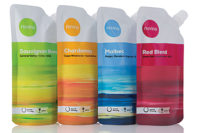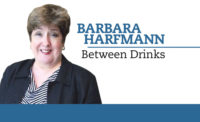Multipacks let Consumers Carry On and On
![]()
Multipacks let Consumers Carry On and On
by Sandy Parlin
Carriers help with hard-to-handle merchandise, and can
mean higher rings on the register
Today’s multipacks are doing for large bottles of liquid refreshment
what the six-pack did for smaller-sized bottles and cans years ago. Is anyone
old enough to remember struggling with a bag full of bottles? With the new carriers,
consumers can buy several large containers or lots of little ones in easier-to-carry
cartons and wraps, and manufacturers often have more merchandising space for
retail displays.
KHS Inc., headquartered in Waukesha, Wis., supplies
packaging and shrinkwrapping equipment to food and beverage companies.
Samantha Bishop, marketing specialist in KHS’ Edgewater, Fla.,
location says the current trend in multipack technology is moving toward
more cartons.
Bishop notes that mega-stores allow consumers to stock
their home pantries with more products. The marketing specialist says that
six- and 12- packs are the current leaders in multipacking because they
give manufacturers more options for display on shelves and
point-of-purchase pallets in the stores. To make the most of the extra
message space, Bishop suggests that multipacked products be placed in more
than one location in a supermarket using a variety of displays.
Looking toward the future, Bishop forecasts thinner, less expensive carton materials and more easy-open perforations in multipacks.
Looking toward the future, Bishop forecasts thinner, less expensive carton materials and more easy-open perforations in multipacks.
Driving Volume
Edward Farley, director of sales for Axon Corp, Raleigh, N.C.,
says most of Axon’s applications create twin packs or four-packs. “Multipacking
is a big driver in the marketplace,” he says. “It’s the ‘buy-one-get-one-free’
mentality. There is more product volume for the manufacturer and a higher perceived
value for the consumer.”
He notes that multipacking provides a bulk product
without the need for a new package design. “You can sell two
half-gallons instead of a gallon. You’re creating new SKUs without
having to create a new package,” he says.
Roberts PolyPro manufactures plastic fixtures for
consumer packaging and parts application equipment to apply the handles,
spouts and other plastic fixtures, all of which can be custom designed. For
the beverage industry it manufactures two-, three-, four-, six- and
eight-packs for plastic bottles. John Eklund, marketing director for
Roberts PolyPro at its headquarters in Charlotte, N.C., says two-packs are
becoming popular in club stores where customers buy in bulk. Sam’s
Club and Costco, for instance, carry 1-gallon and 96-ounce containers.
“With our carriers, we can put the UPC code right on the handle.
You can have two single gallons of juice with a handle in between them containing
the UPC code,” he says. “Products can be sold in two ways; as a gallon of juice
for regular grocery stores and a multipack for club stores. You put a handle
on it and it becomes a different package.”
A small machine that makes minimal impact in the line,
adds the handles, which can be applied right into the cases just before
they go out the door. Roberts PolyPro offers the carriers in custom colors,
and Eklund notes that the handles help avoid the loss of package integrity
that can occur when alternative shrinkwrap is punctured or tears.
Eklund says the handles also can be attached to large gallon-sized
bottles in addition to their use in multipacking. Roberts PolyPro offers single
plastic bottle carriers for that purpose. “The 128-ounce bottle can be difficult
to manage. Some have handles actually blown into the bottle,” he explains. “We
make the plastic carrier that is added to the neck of the bottle afterwards
to aid in lifting and pouring. Our offering is unique — we ship it in a welded
format, similar to the way staples are welded. The carriers are welded together
for co-packers who do the bottling and are placed onto the equipment in stacks
and loaded in groups in an automatic application.”
Wrap It Up
Making the case for shrinkwrap, Lani Craddock, director of new
business development at Exopack in Spartanburg, S.C., says pre-printed shrinkfilm
gives multipacks a new identity on store shelves. “Instead of seeing three or
four individual labels on a can or bottle showing through a film, the product
brand covers the entire front, top and back of the package,” she says. “It is
much easier for consumers to find their favorite brands and for brand managers
to communicate their brand promise.”
She adds that shrinkwrap ensures a full SKU scan of
the multipack instead of a misread of an individual unit within the
mutlipack. Register efficiency is improved by facilitating a single scan
rather than a multiple same-item scan.
Craddock notes that multipacks lend themselves to
traditional shelf placement and special end-caps, front-of-store
promotional displays and refrigerated and frozen cabinets. “No area
of the supermarket is off limits to multipacking,” she emphasizes.
“As shrink packaging equipment continues to evolve, material
manufacturers such as Exopack have stepped up to the plate with materials
that provide better clarity, toughness, sealability and shrink
characteristics.”
Looking for a reprint of this article?
From high-res PDFs to custom plaques, order your copy today!






